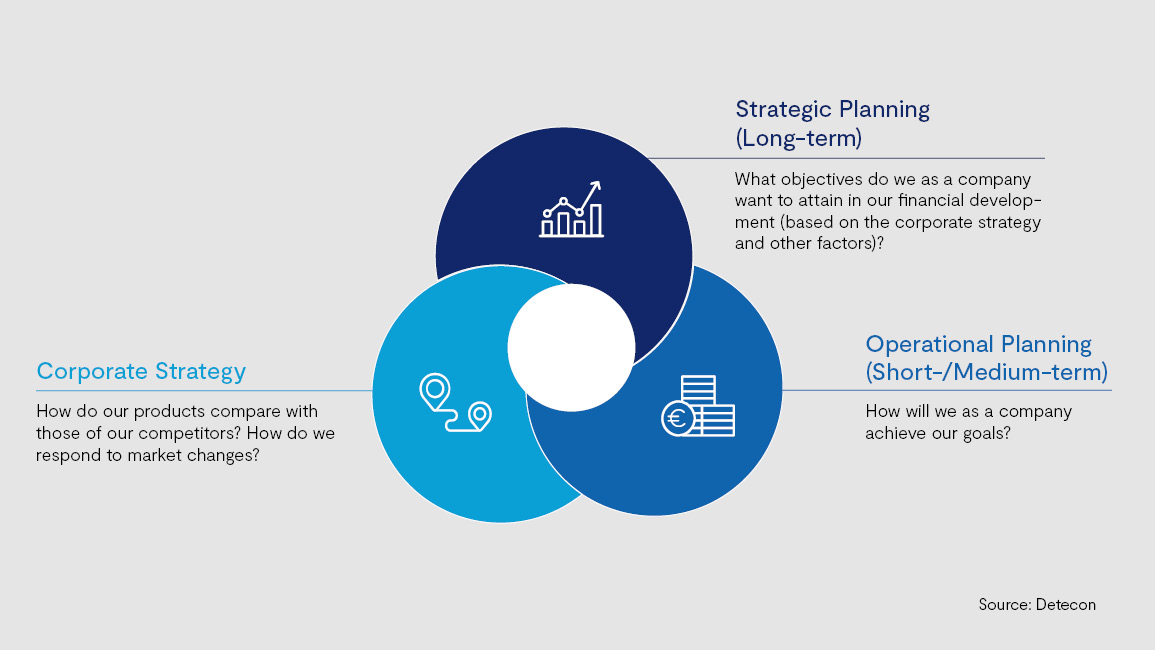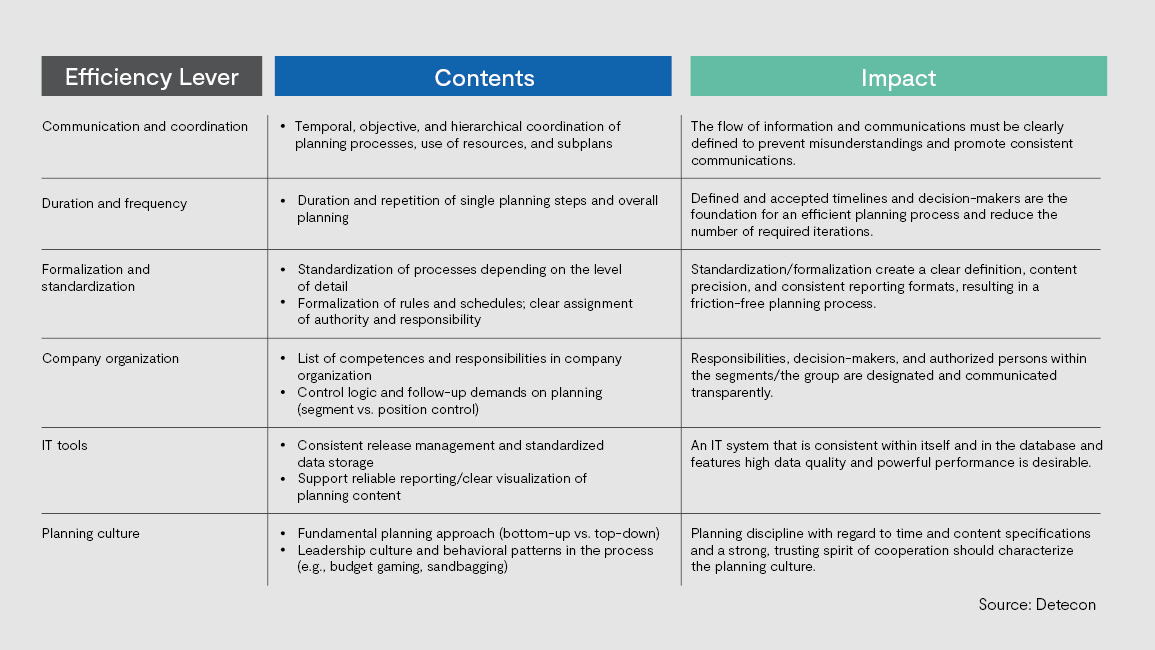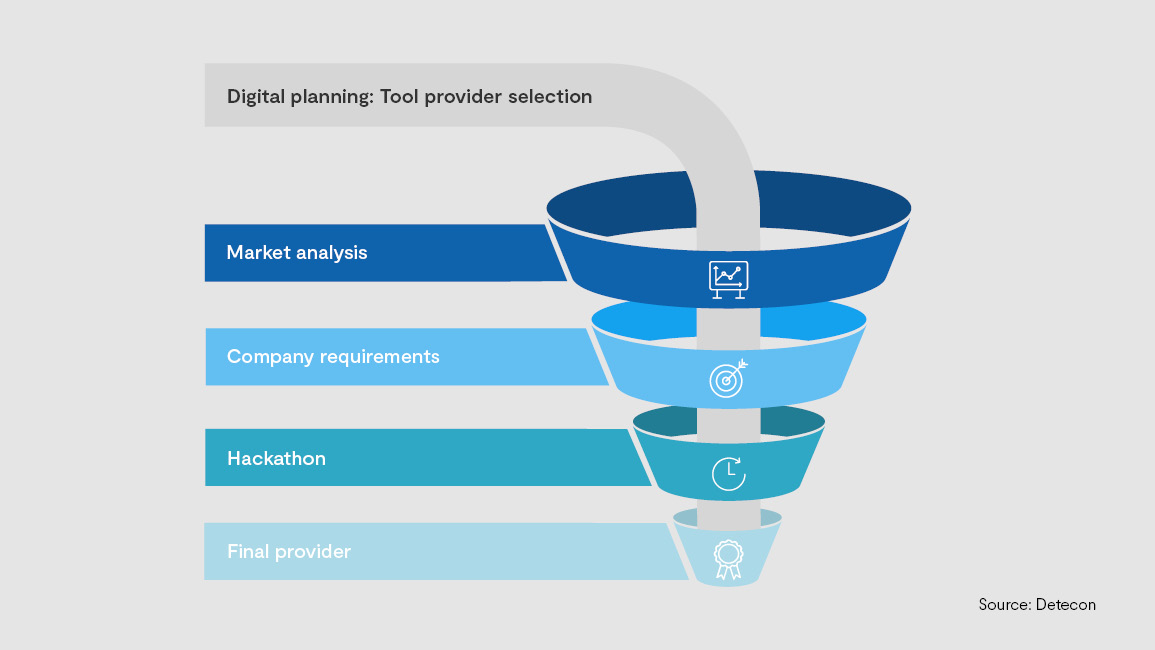Making the planning process more efficient and having the information needed for planning available quickly, regardless of location and always up to date, are the greatest challenges for corporate planning. At this point at the latest, considering how you might use planning tools turns out to be a sensible step. Multi-cycle planning activities tie up valuable resources in the organization. Controlling must repeatedly ask itself some crucial questions. Is the planning tool now in use the right one? Is it efficient? Or would we be better off with a different tool?
Recent studies show that the relevance of digital reporting and business intelligence solutions is on the rise, growing at an annual rate of 5.74 per cent. In terms of annual sales volumes, Germany has a share of <10 per cent (approximately 5.3 per cent).
Analyze requirements from Finance and Controlling
The primary challenge in Finance and Controlling departments is selecting the right option from among the multitude of available tools; the correct choice will aid in the digital transformation of the planning process and subsequently raise the level of efficiency. In this age of digital transformation, daily business allows only a limited amount of time to deal with and implement these tools, but an intensive discussion before introduction is essential to make the promised advantages of the “new” planning tool measurable in the company.
As relevance looms larger, the related expectations and the demands made on the controlling processes and tools in companies also increase. In addition to the change in controlling processes, there is also the key question of whether the current tools are adequate (status quo), and if not, how new tools might serve as a catalyst enabling controlling to keep pace with the rising requirements. This is precisely the point for the presentation below of an approach to the evaluation and proper selection of new tools for the planning process, one of the most crucial tasks of controlling.
Planning in Finance is understood to be a process that is oriented to both operations and strategy and incorporates the financial and non-financial information of companies into the planning content. Moreover, planning dimensions that always follow the strategic orientation of the company have been firmly fixed in the process:

The success of the planning is dependent on the three dimensions of lead time, resource efficiency/use, and planning quality. Planning quality is measured as a combination of its deviating no more than slightly from the as-is situation, the planners’ commitment to achieving the results, the completeness of the planning content, and the resilience of the planning outcome.
Efficiency levers for planning success
A total of six efficiency levers/areas are highly relevant as they have a direct impact on planning success:

Controlling, a key player in the planning process, has a variety of automation options at its disposal that are relevant for the aforementioned efficiency levers and, at the same time, can provide the means to steer the quality of the planning.
The major questions and requirements:
- Flexible scenario analyses and quantity and price integrations for ad-hoc reports and target/actual analyses
- Versioning of planning scenarios
- Automatic transfer of data; consistency across all process steps instead of manual validation and consolidation
- Automatic generation of reports (output sheets) for different addressees
- Integration of workflows to render team interactions more efficient and to concentrate on one planning environment
- Integration of artificial intelligence (e.g., using predictive analytics) for predictions and generation of analysis content
The trend in corporate planning — in the direction of lining up with the aforementioned requirements — motivates companies to seek a reduction in silo thinking during the planning process (subplans wall themselves off). Instead, an overall image of company-wide planning must evolve, one that pays no heed to departmental, divisional, and segment boundaries and that must be developed as a joint effort. The priority is on holistic consistency and a reduction of planning iterations. The ultimate vision of moving away from subplans of separate control contents (silos) in the long term leads to a need for action in dealing with new technological, process-related, and organizational aspects.
Selection criteria for the right tool choice
Detailed insights into the needs of the department (Finance) reveal that comprehensive planning tool assessments are possible and necessary. First and foremost, the top priority is to have measurable criteria based on customer needs for the evaluation of the currently available tools and trends prior to any potential implementation as this will save time and money for the organization.
The selection criteria for the right tool choice followed hand in hand with the efficiency levers of planning success (see Figure 2). For example, both “communication and coordination” and “duration and frequency” play an essential role in that the involved planners want flexibility, independence, and speed for the future. Future system-controlled workflow processes in digital planning masks and based on stored schedule and communication plans should be of help in satisfying these demands more precisely.
Moreover, standardization in the aforementioned process landscape is also imperative. Predefined planning masks provided by the system create formalization and uniform reporting formats. Uniformity is further fostered by the fact that a new structure of the planning process with the related tools also requires (new) IT tools in most cases. The planning contents can be optimally versionized by the (cloud-based) tool processing of the system and offer further support through reliable visualization of the planning contents. A harmonized IT system landscape is desirable at this point and is also the goal of the potential tool introduction.

A mere 4 steps to the optimal tool
The first step is the conduct of a comprehensive market analysis to determine which of the numerous possible tool providers offer the greatest advantage/benefits, to identify them (and them only) as relevant, and to compile them in a short list. They include prominent suppliers as well as medium-sized solution providers.
In the second step, these providers and their tools are evaluated on the basis of customer-specific planning requirements such as implementation speed, independent construction of planning masks, and "what if scenarios"; the efficiency levers mentioned above are useful aids during the procedure (see Figure 2). Even at this early point, it is determined that numerous providers/tools (usually up to 50 per cent) do not meet the company or customer requirements; they are removed from the list and are not the subject of any further consideration. This preselection is objective, transparently comprehensible, and free of any manipulation and customer preferences.
During the third step, the so-called hackathon, the providers of each tool present the details of these preferred tools to the customers/end users in the form of concrete practical examples and solutions. This demonstration is always based on the previously communicated planning requirements or required use cases so that a level playing field is created for all providers. Comparability of solutions is the top priority rather than a multitude of occasionally radically different and heterogeneous tool presentations.
These hands-on meetings are a chance for customers to work actively with the tools and personally test them for usability/fulfillment of requirements. Another factor is that technical adaptations are also demonstrated right away so that planning requirements (on the customer side) and the sought technical solution (on the supplier side) can be tested immediately in context.
Concluding the process, the final decision for the best tool or provider based on the hackathon and testing by the customer is reached in step 4. Another advantage of the concrete results during this detailed tool presentation and modification is the generation of practical solutions that do not have to be recreated again as part of the subsequent implementation, which saves time and effort.
The step-by-step process of qualified tool selection described here makes it clear that while the possibility to choose a provider or tool according to precise requirements is certainly relevant, the involved parties should also collaborate in considering all aspects of the subsequent implementation. The described savings of time and effort (e.g., results of the hackathon) open up space for possibly even more detailed technical implementations that will further optimize the technical implementation.
From controller to data scientist
The palpable pressure of digitalization coupled with the challenges in the Finance department mentioned at the beginning compel a strong need for actions to address actively the changes in the planning process (in the Controlling department). The circle keeps closing in that traditional controller/finance staffs who find themselves in a data-driven environment are evolving into data scientists. Measures such as the automated consolidation of data in a uniform system or tool improve the quality of planning and can heighten efficiency enormously.
An examination of the previous planning process and new, digital developments is worth the time and effort because the current framework conditions can be verified. Planning content and depth and the degree of complexity of planning can be redefined and improved. There are also effects on the corporate organization and on planning culture. Some of the questions that are being rethought:
- How is my previous control logic set up (segment vs. position control)?
- What fundamental planning approach do I pursue (bottom-up vs. top-down)?







